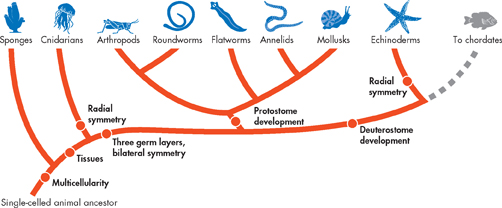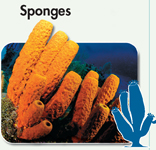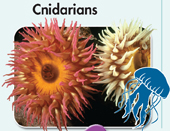
FIGURE 26–3 Cladogram of Nonchordate Invertebrates This diagram shows current hypotheses of evolutionary relationships among major groups of animals. During the course of evolution that produced these different groups, important traits evolved. These are shown by the red circles (nodes). Note that the invertebrate chordates, which you will learn about in the next lesson, are not shown. Also, note that nonchordate invertebrates do not form a clade.
dNonchordate Invertebrates
 What does the cladogram of nonchordate invertebrates illustrate?
What does the cladogram of nonchordate invertebrates illustrate?
The groups of living invertebrates are shown in Figure 26–3.  The cladogram of nonchordate invertebrates presents current hypotheses about evolutionary relationships among major groups of modern invertebrates. It also indicates the sequence in which some important features evolved. These features include body symmetry, cephalization, segmentation, and formation of a coelom. Many of these features evolved in Cambrian animals.
The cladogram of nonchordate invertebrates presents current hypotheses about evolutionary relationships among major groups of modern invertebrates. It also indicates the sequence in which some important features evolved. These features include body symmetry, cephalization, segmentation, and formation of a coelom. Many of these features evolved in Cambrian animals.
| INVERTEBRATE | PHYLUM | DESCRIPTION |
|---|---|---|
|
Sponges are members of the phylum Porifera (por IHF er uh), which means “pore bearers” in Latin, reflecting the fact that they have tiny openings, or pores, all over their bodies. |
Sponges are classified as animals because they are multicellular, heterotrophic, lack cell walls, and contain a few specialized cells. Sponges are the most ancient members of the kingdom Animalia and are among the simplest organisms to be placed in the clade Metazoa, with all other multicellular animals.
|
|
Jellyfishes, sea fans, sea anemones, hydras, and corals are all members of the phylum Cnidaria (ny DAYR ee uh). |
Cnidarians are aquatic, soft-bodied, carnivorous, radially symmetrical animals with stinging tentacles arranged in circles around their mouths. Some, such as corals, have skeletons. They are the simplest animals to have body symmetry and specialized tissues. Some cnidarians live as independent individuals. Others live in colonies composed of many individuals.
|
|
Table of Contents
- Formulas and Equations
- Applying Formulas and Equations
- Mean, Median, and Mode
- Estimation
- Using Measurements in Calculations
- Effects of Measurement Errors
- Accuracy
- Precision
- Comparing Accuracy and Precision
- Significant Figures
- Calculating With Significant Figures
- Scientific Notation
- Calculating With Scientific Notation
- Dimensional Analysis
- Applying Dimensional Analysis






 DOL•31
DOL•31
 DOL•32–DOL•33
DOL•32–DOL•33